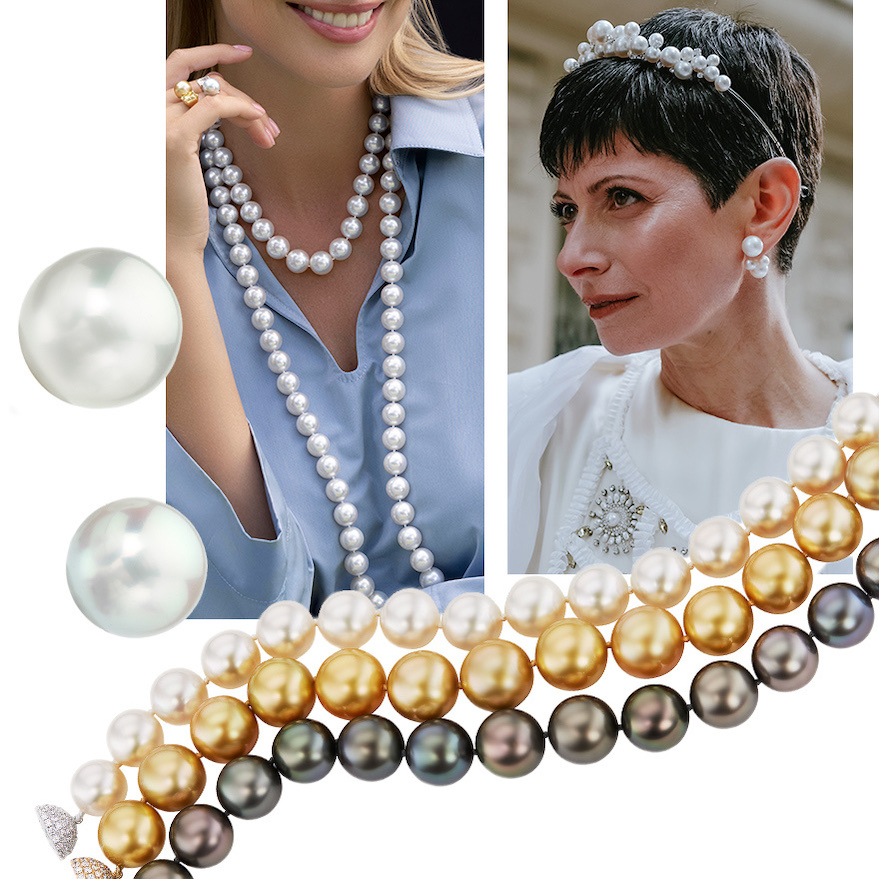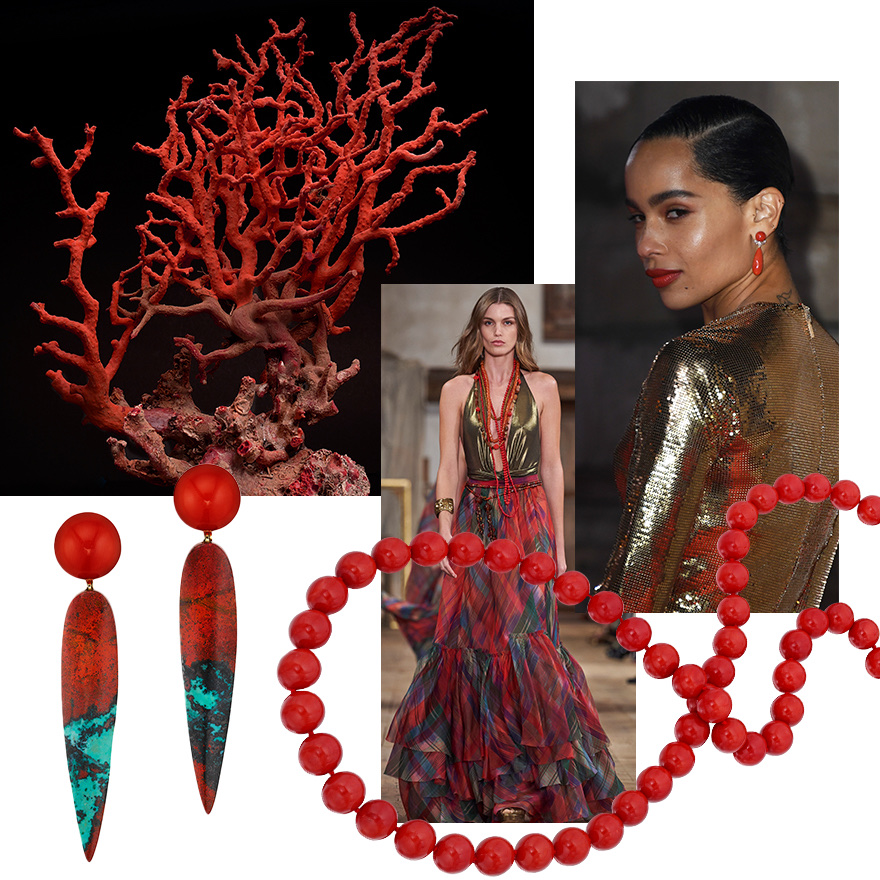
Sardinian Coral – Insights into the Vermillion Jewelry Treasure from the Sea
Sardinian coral is one of the most beautiful treasures from the Mediterranean Sea. Coral jewelry has been sought after since ancient times and is still very much in demand today. In partnership with Liverino 1894, Assael has curated the largest collection of Sardinian coral in North America. The assortment is prized for its all-natural crimson color, its unusually large sizes, and its remarkable consistency of hue. Best of all, Sardinian coral has nothing to do with reef coral – it is an entirely different species. It is responsibly sourced and heavily regulated to ensure its viability as an important species for many years to come. Here, we will explore the history of Sardinian coral – its captivating allure and the many legends that surround it, as well as its unique quality factors, and its return to high fashion in recent years. Join us as we dive into the mystery and magic of Sardinian coral … the exquisite treasure from the depths of the sea.
Origins & Lore
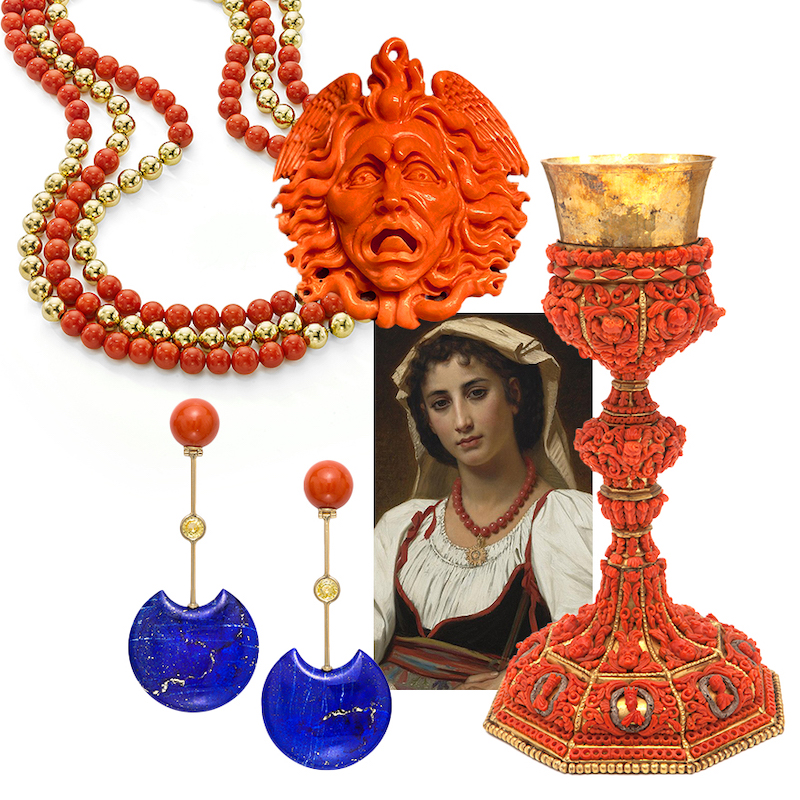
According to “coral king” Vincenzo Liverino, head of Liverino 1894, the five-generation coral business in Torre del Greco, Italy, Sardinian coral has “cast an ancestral spell on mankind for millennia.” Ovid, Pliny the Elder, Theophrastus are just a few of the authors and historians who have tried, over the centuries, to study and define what coral actually is. Sometimes they were closer to the truth, but more often, it is the folklore and the legends about this vivid red gem that have prevailed.
Over 6,000 years ago, Sardinian coral was used by the Sumerians in fine jewelry design. Liverino notes that the “because of its blood-like color, coral was believed to be endowed with magical virtue and power – it was often used in ancient cultures by artisans to craft auspicious amulets and fine jewelry.” The Greeks believed coral to be the drops of blood that fell from the head of Medusa, after it was severed by Perseus in Greek mythology. The Romans, however, thought coral was more changeable and elusive, tracing its nature to seaweed that was softened by saltiness and hardened by the air. Liverino suggests that there has always been a heated debate among scientists, philosophers, botanists, naturalists, and poets about the origins of coral, the beautiful “trees” that live deep within the sea. These specialists could never agree whether coral was a vegetable, a mineral, or of animal origin. “Each statement was followed by mistrust, denials, and chants of dissent.”
Liverino notes that coral was also considered a holy stone in many religions, by custom and belief, especially in Japan and China. In Tibet, Nepal, and Afghanistan, they believed that the crimson gem protected one from bad luck and disease. For Nigerians, it represented a status symbol for the chieftain or king. Coral has even been used for medical purposes or as an aphrodisiac in India. All of this legend and folklore imbue Sardinian coral with magic, says Liverino. “It is the magic inherent in coral that makes it increasingly appreciated and precious.”
Thanks to biology, we understand precious coral to be a group of the genus Corallium. Sardinian Coral is specifically from the species Corallium Rubrum. All coral is the exoskeleton of a coral polyp, a small plant-like marine animal. The Sardinian coral polyps grow and thrive in dark shady places, deep in the waters of the Mediterranean Sea, up to 200 meters below the water’s surface. Gem expert and teacher Rui Galopim de Carvalho expanded upon the scientific terminology in his guest blog post Understanding Precious Coral. “Corals are animals, belonging to a group called the Cnidaria phylum, where there are more than 7,300 species… however, the so-called precious corals that are used in fine jewelry are restricted to a very small group, known in biology as the Corallidae family. In this group there are about ten species of coral used in jewelry, and these do not live in the same ecosystem, nor at similar ocean depths, as their relatives in the reefs.”
Quality & Matching
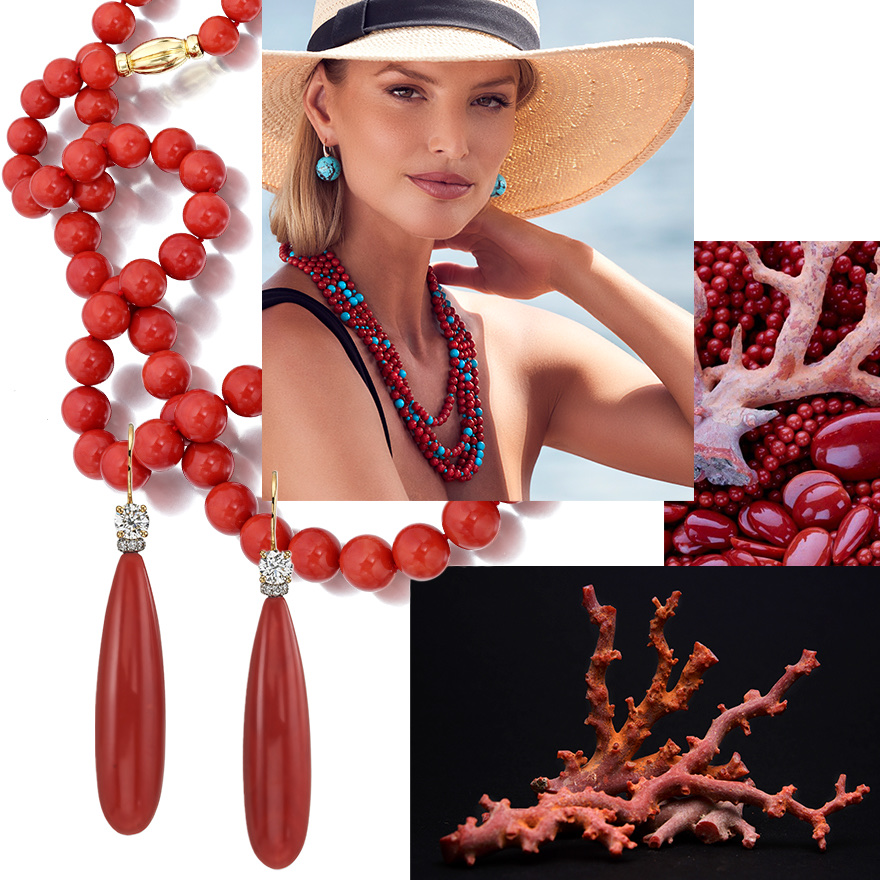
Clockwise from upper left – Assael Sardinian Coral strand 32.5″ long, Elegance with Attitude image from David Benoliel photography – model wears a multi-strand Assael Sardinian Coral and Turquoise necklace and Turquoise and Diamond earrings, Sardinian Coral beads, natural Coral Polyp, Assael “Positano” Sardinian Coral and Diamond earrings
The quality of precious Sardinian coral is determined by various factors, just like any other gemstone. According to the International Gem Society (IGS), the value of precious coral is based on color, saturation, size, cut, and polish. Color, saturation of color, and consistency of hue (in a strand, for example) are first and foremost. The vibrancy of color is what makes coral so beautiful and so highly coveted by gem enthusiasts. Corals in red, orange, and pink hues tend to have the highest values, especially when the saturation of color is intense. Sardinian coral is known for having a natural crimson hue, deep reds, and beautiful shades of orange. The larger the beads, typically, the higher the value because most coral “trees” are fairly small. The larger specimens are atypical. That type of rarity in the gem world can drive prices higher.
The other coral quality factors derive from the workmanship – the cutting and the polishing. At Liverino, their craftsmen have been working with precious coral for five generations in their esteemed atelier and museum of coral in southern Italy. Their coral processing has remained unchanged for centuries. “All of our corals are worked exclusively by hand,” notes Assael’s partner Liverino, the renowned coral king. “From cutting of the branches to the forming and shaping of the beads, the drilling, the polishing, the matching – it is all done by hand.” The cut and polish of the gem coral beads determines the smoothness of the surface and affects its ultimate value. The more beautifully prepared the coral, the more valuable it will be.
Liverino notes that for Sardinian coral, the depth of color and the evenness of that vibrant red tone throughout each bead adds to the value and the rarity. Matching is an important aspect of coral strand value. Similar to pearls, the sea’s other great gem, the beads that form coral strands must be matched by experts. Often the matching can take years of collecting to accomplish. Sometimes, the hue of a given coral specimen is quite distinct, and the only way to match the beads perfectly is for them to all come from the same coral “tree.” Especially for larger specimens, which are naturally rarer, the value increases dramatically when there is an intense depth of color that is expertly matched in a strand or bracelet or pair of earrings. Such works of art are highly prized and will endure as jewelry heirlooms for future generations to enjoy.
Ethical Sourcing
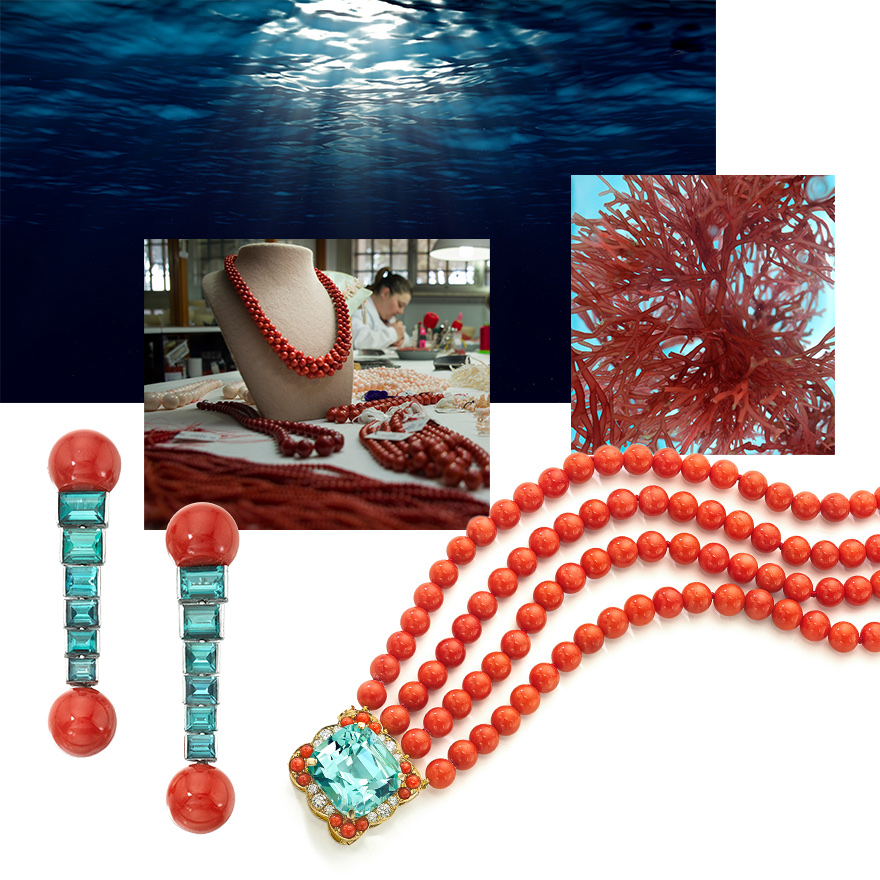
Because coral is an important species, the fishing and harvesting of corals is very heavily regulated by international governments, and rightly so. The tight controls on the coral industry will preserve the Mediterranean coral species, so that Sardinian corals are never depleted or overfished. As mentioned above, all of the Assael Sardinian coral comes from Liverino 1894 with proper legal importation. Given the legal documentation involved, the few species that make up precious corals are some of the most traceable gems in the world, much more so than many other types of mined gemstones.
Throughout the Mediterranean, coral fishing is limited to a few months of the year, and collection by divers is permitted, but they can currently only fish coral that lives between 50 and 100 meters deep. However, Liverino notes that the use of robots is being studied which would allow for even more sustainable harvesting at depths ranging from 100 to 1,000 meters. In Japan and Asia, the regulation has been in place for several decades with routine alternation of fishing areas. Some places in Japan only allow fishing with robots.
It is important to note again that precious corals used in fine jewelry are not the same species as those in the great coral reefs. Coral from the coral reefs grows and thrives in shallow waters, making it more susceptible to the effects of global warming. Fishing of these corals is rightly restricted.
Given the strict adherence to international laws, precious corals can now be cherished as the absolute treasure that they are. They can be worn with confidence and assurance that the species will never be depleted.
Coral in Fashion

According to renowned author, jewelry historian, and journalist for Financial Times’ How To Spend It Vivienne Becker, “Coral is making a stunning comeback,” with coral appearing in high jewelry collections in recent years at Cartier, Bulgari, Fabio Salini, Hemmerle, David Webb, and more. Christian Dior also used both short and long coral strands on the runway in its Spring/Summer 2021 ready-to-wear collection, proving coral’s enduring fashion relevance in modern times.
Becker further commented on coral’s enduring fashion appeal… “Coral is the color of a Mediterranean summer. Like the pearl, coral was surely one of the earliest and most mysterious gem materials discovered and prized by man, imbued with spirituality, with magical powers to heal and protect, to connect to the divine. Yet while the pearl is secretive, understated, quietly alluring, coral is extrovert, exuberant, and vibrantly hot-blooded.”
Bright red and orange corals have always been popular with resort wear. The carefree styles and typically light-hued fabrics pair beautifully with the luscious tones of Sardinian coral. The coral beads add bright pops of color to eyelet lace blouses or anchor the flowing full sleeves of caftans and swimwear covers. Perfect for an island resort, given its deep-water origins, Sardinian coral breathes a fresh air of sophistication into the many florals and beaded or feathery fabrics popular for vacation attire. It is also a wonderful complement to the plethora of vermillion and pink fabrics in the Spring/Summer ready-to-wear collections. Ralph Lauren recently featured a few looks in his latest S/S 2024 show with layered coral necklaces (see feature image above).
Coral is also perfect for year-round wear. It adds an element of understated elegance to any outfit. Unlike bling or faceted diamonds and gemstones, coral is smooth and opaque. The rich, fiery red tones of Sardinian coral are perfect to adorn luxury fabrics like cashmere or silk. The singularity of color in a coral strand or button earring also works well with floral and geometric prints, as well as with the proliferation of beaded, sequined, or metallic fabrics that have become popular in contemporary fashion. As an example, Zoë Kravitz wore a pair of Assael Sardinian coral earrings on the red carpet at the BAFTA awards a couple of years ago with a solid gold metallic dress, as elegantly styled by Andrew Mukamal.
Sardinian Coral is undoubtedly an exquisite treasure from the sea, and when properly cared for, a strand or piece of coral jewelry will maintain its beauty and enchanting color for many years to come. Understanding its origins, its quality factors, its ethical sourcing, and its enduring fashion appeal helps us to value and appreciate precious coral as it properly deserves.
Feature image at top – Clockwise from upper left – Zoë Kravitz in Assael Sardinian Coral earrings at the BAFTAs styled by Andrew Mukamal, Assael Sardinian Coral strand, Ralph Lauren S/S 2024 (Launchmetrics Spotlight), Assael NatureScapes earrings featuring Sardinian Coral and Sonoran Sunrise Jasper, Coral polyp from the depths of Mediterranean Sea
If you liked this, you might also like…
Sustainable Coral – Exquisite, Rare and Exceedingly Precious
Sciacca Coral – Naturally Sustainable Treasure from the Depths of the Mediterranean
Defining Exceptional – The Beauty and Luxury of Angel Skin Coral
Posted on Sep 20, 2023 in Pearl Education by Duvall O'Steen
Articles you may also enjoy
Join our Mailing List
Join us for magnificent pearl trends and exclusive treasures. Discover a world that is truly ... beyond rare.

Feeling inspired?
Consider this your invitation to the House of Assael. Find your closest luxury jeweler using our map search and start your journey to timeless elegance.



